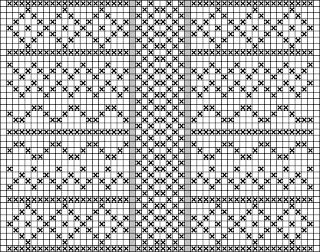Just what is a steek?
A steek, in knitting terms, is a group of extra stitches that are added in areas where you'd like to be able to go back and cut open - like cardigan fronts, armhole openings, even neckline shaping.
If you are a sewer, they are sort of like seam allowances.
A "steek" is usually 8-10 stitche s - I like 10. Knitting in the round, stitches 1through 10 - right to left - with stitches 1 and 10 being the "edge" stitches - these stitches are adjacent to the body of your knitting and are knit in the background shade of the row.
Stitches 2 thru 9 are the extra stitches that are there to protect the body of your knitting.
If you are knitting a pullover, and you've finished the body in the round up to the underarms - a stitch, or stitches at each underarm are cast off (or placed on a holder) and steek stitches are cast on to allow you to continue knitting up to the shoulder line.
So if you'd like to try a steek swatch like this one......you'll need two shades of yarn - 100% wool (not superwash) to get the full steek experience!
This chart is 52 stitches wide - and you could knit it as a practice steek swatch.
The greyed blocks are the edge stitches of the steek - always knit in the background. The steek stitches between these edge stitches are knit alternating the background and pattern shades. You'll notice that the stitches 5 and 6 are knit in the same shade - this gives you a nice neat line of stitches to cut open later.
To knit this swatch - cast on 52 stitches in your background shade. Reading the chart from the right to the left, knit every row (to simulate knitting in the round) - breaking off the yarn at the end of each row. Knit the first and last stitch of each row of knitting with both shades of yarn - this will keep the edges tidy.
When you have finished all 41 rows of the chart - cast off with the background shade.
Wash and dry your swatch. (Isn't it pretty?)
Now - IF you have used 100% wool yarn - you can just cut right up between stitches 5 and 6 of the steek and the stitches won't go anywhere - the cut stitches will get a bit wobbly looking, but they will be fine!
If this was a sweater - and you can practice this on your steek swatch - you'd pick up stitches for say a cardigan band between the last body stitch and the steek edge stitch. A swatch is a great way to try these techniques that may be new to your knitting repertoire.
If you are a sewer, they are sort of like seam allowances.
 |
| You can see on this piece of knitting the centre front steek to make it a cardigan, and the steeks at the armhole openings. (This is another of my abandoned designs LOL!) |
Stitches 2 thru 9 are the extra stitches that are there to protect the body of your knitting.
If you are knitting a pullover, and you've finished the body in the round up to the underarms - a stitch, or stitches at each underarm are cast off (or placed on a holder) and steek stitches are cast on to allow you to continue knitting up to the shoulder line.
So if you'd like to try a steek swatch like this one......you'll need two shades of yarn - 100% wool (not superwash) to get the full steek experience!
This chart is 52 stitches wide - and you could knit it as a practice steek swatch.
The greyed blocks are the edge stitches of the steek - always knit in the background. The steek stitches between these edge stitches are knit alternating the background and pattern shades. You'll notice that the stitches 5 and 6 are knit in the same shade - this gives you a nice neat line of stitches to cut open later.
To knit this swatch - cast on 52 stitches in your background shade. Reading the chart from the right to the left, knit every row (to simulate knitting in the round) - breaking off the yarn at the end of each row. Knit the first and last stitch of each row of knitting with both shades of yarn - this will keep the edges tidy.
When you have finished all 41 rows of the chart - cast off with the background shade.
Wash and dry your swatch. (Isn't it pretty?)
Now - IF you have used 100% wool yarn - you can just cut right up between stitches 5 and 6 of the steek and the stitches won't go anywhere - the cut stitches will get a bit wobbly looking, but they will be fine!
If this was a sweater - and you can practice this on your steek swatch - you'd pick up stitches for say a cardigan band between the last body stitch and the steek edge stitch. A swatch is a great way to try these techniques that may be new to your knitting repertoire.




I am so looking forward to cutting the steek on my Shetland Wool vest http://yarnings1.wordpress.com/2011/07/08/lichen-waistcoat/ so I can see for myself this magic. Not even have to crochet? Wow ! Are you sure ? Nothing at all? I was going to crochet the edge, but that only adds bulk. Thank you for this post ! I have done a few steeks,but I have not done a Shetland Wool knitted steek yet.
ReplyDelete